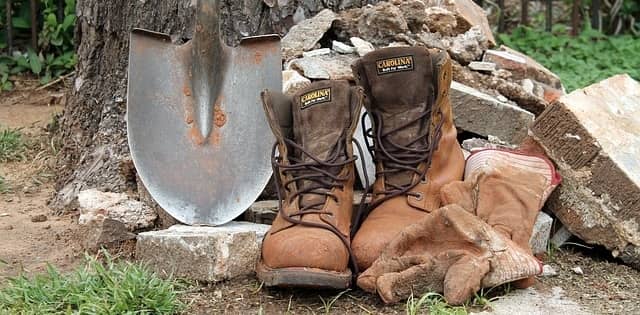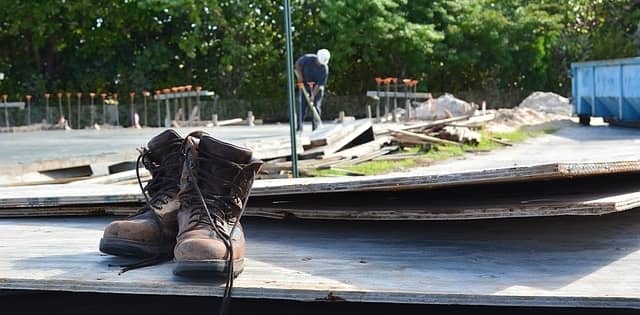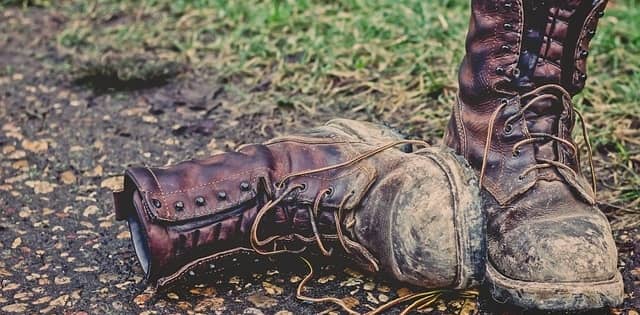New materials being used in work boots
Every kind of work boot is created for a different purpose. Hence, a different type of material goes into the construction of work boots, each with their own unique advantages and uses. Before choosing the kind of work boot to buy, consider your line of work and the material that is best suited for your particular environment.
Rubber is commonly used in a range of different work environments especially those where a good level of waterproofing is required. Rubber work boots are waterproof and therefore, very easy to clean. However, you cannot really adjust the fit of rubber work boots. That means that they can sometimes be a pain to walk in. These kinds of boots come both with toe protection and without it.
Apart from rubber, other materials that are commonly used in work boots include:
Leather
Leather is perhaps the most popular and common choice when it comes to work boots, primarily because of its durability. Work boots made of full grain leather are water resistant and highly durable. However, they can be very thick which increases their weight and reduces their breathability. For added costs however, one can achieve full waterproofing with leather work boots. One major benefit that leather work boots have over rubber work boots is that they offer a better fit. This is because leather can easily be molded for different feet shapes. Just like rubber work boots, leather work boots also come both with toe protection and without it.
Nylon
Though nylon work boots are less durable as compared to both leather and rubber boots, they are far more breathable and durable. Apart from that, nylon boots have the advantage of being more comfortable due to the softness of the material. They happen to be water resistant but cannot achieve full level of waterproofing which makes them unsuitable for work areas that involves water levels above the feet. Work boots are not as durable as leather, but they are more lightweight and breathable.
PVC
PVC stands for polyvinyl chloride and is a type of plastic polymer used in work boots because of its durability and protection from chemicals. Similar to rubber, boots made from PVC are durable, waterproof, and easy to clean, but are not always that comfortable because they tend to be more rigid.
A combination of rubber, nylon, and leather
Today, a combination of rubber, nylon, and leather is often used to construct different parts of the boot depending on the requirements. The leather adds greater strength and durability, whereas a rubber sole provides a good level of waterproofing. At the same time, nylon meshes outfitted on the boot increase the breathability and prevent the feet from retaining too much moisture.

New materials used in work boot soles
The material used in the boot sole is as equally important as the material used in the upper part of the shoe. This is obviously because the sole provides added protection and support for under the feet.
The most common material that is used in boot soles is rubber. Rubber is useful because it is slip resistant, and resists both oil and abrasion. The usage of proprietary rubbers adds greater performance and safety properties in the work boot.
In addition to rubber however, a range of other materials are now being used either alone or in combination with rubber primarily due to their unique characteristics. These materials include:
TPU
TPU stands for thermo-polyurethane. Thermo-polyurethane soles provide greater resistant to oils, abrasion, and a range of chemicals as compared to rubber soles. Often at times, this material is used in combination with rubber. This reduces the overall weight of the sole since TPU happens to be much lighter than rubber. Moreover, TPU soles also offer great resistance to splitting.
EVA
A number of work boots have soles that use rubber on the outsoles with more complex materials used on the midsoles to provide better comfort. Typical material used in the manufacturing of midsoles include EVA (ethylene vinyl acetate). EVA is a material with foam-like properties with great durability and flexibility. This allows better comfort for feet.
Steel toes
Boots with steel toes caps are highly useful for those who work in industrial environments where it’s important to protect feet from falling objects and walking through debris. However, one downside of steel toe caps is that they add weight in the shoe and are prone to conducting temperature. There are a range of alternative composite materials for toes that include dense plastic, kevlar, and carbon fiber. These materials do not conduct heat and are lightweight. At the same time, they provide a good level of safety in construction areas.

How to measure your feet for a proper fit
Throughout the years, the size of our feet can change by as much as an inch. That’s why, at any time, it is of extreme importance to get the best fit possible.
Tip: I personally know that if you don’t take the time to have your feet measured it will definitely make your life miserable on site if you end up buying the wrong size. I once bought a pair of new work boots in a rush; the length was a good fit, so I bought them. The next few days were miserable to say the least. I had bought a pair that was wider then what I needed. Good thing I was able to exchange them for another pair because we all know that they are not cheap to buy.
Here are three different ways you can measure your shoe size:
1: MEASURE THE BASE OF YOUR FOOT
Measuring the base of your foot is perhaps the easiest of all steps. The US sizing chart is the most common of all standards based on which brands all over the globe manufacture their shoes.
In order to find your size based on the US sizing chart, simply head to a shoe store near you. These numbers will provide you a baseline on which you can find the approximate size that is likely to be the right fit for you.
2: USE A CURRENT PAIR OF SHOES
A number of brands that manufacture shoes today are focused on providing the best customer service to their potential customers. You can always mail them a pair of shoes that fit you just right. Based on that size, they will most probably manufacture your preferred choice of work boots. A trusted manufacturer will surely mail you the old pair along with your order, so do not worry about that!
However, make sure that the sample that you are sending to the manufacturer is a current pair that you still use. Sending an old pair of boots won’t really help! This is because the size of our feet changes slightly over time. Over a difference of a couple of years, however, the change in the size of feet could be quite significant. This difference could be of as much as 1 inch.
3: DRAW AN OUTLINE OF YOUR FEET
Drawing your feet on a piece of paper is yet another way of measuring your feet accurately for boots. For this method, you will require a piece of paper large enough to cover your entire feet. You will also need a pen, eraser and a measuring tape/ruler.
Firstly, we must get the right length of both the feet. Follow the process below in order to get accurate figures.
- Sit down with your back straight and your legs at a right angle to the ground.
- Put the blank piece of paper underneath your feed on a hard floor.
- Draw your right barefoot on the piece of paper.
- Make a dark mark at the end of your heel while keeping the pencil/pen vertical. Take a pen or pencil and make a dark mark at the end of the heel. Make sure the pencil is perfectly vertical while doing so.
- Now, put a mark on the tip of your toe.
- Use a ruler or a measuring tape to measure the length between the two marked ends, one at the end of your heels and the other at the tip of your toe.
- Turn the paper towards the other side, or if there is space, move on to the left end of the paper. Now, repeat the same procedure that which you used for your right feet.
- Once you have measured the length of your feet, you must find out the width. However, those who are overweight might have a feet width that deviates from the standard. To measure the feet width, follow the same process and use a ruler to measure across the widest width of your feet.
Whatever your feet measures, use a standard US sizing chart to find your corresponding standard size. In case your measurement lies between two different sizes, simply move on to the larger size.

Is there any difference between summer and winter rubber work boots
In general, there is not much difference between summer and winter rubber work boots, other than the thermal technology for heat retention in winter. Also, rubber boots with nylon padding are more breathable and are hence more suitable for summers. However, in case you want full waterproofing based on your work environment requirements, then you won’t have any room for nylon padding.
While many people consider being waterproof the most important aspect of rubber boots, keeping your feet dry from sweating inside the rubber work boots is also a major issue. In this post 7 tips to keep your feet dry inside rubber boots we cover this and more.
Having a breathable pair of work boots also helps a lot. Depending on what you need them for, instead of opting for a rubber work boot, a nylon work boot can provide a good level of breathability along with reasonable level of water protection.
In general, nylon boots are more breathable than both leather and rubber. That means your feet are not likely to remain soaked with moisture inside the boot. Nylon work boots are also durable. However, while these boots do provide a good level of water resistance, they are not fully waterproof.
How to Waterproof Your Leather Work Boots
1) If your boots have been used on site for awhile then you’ll want to give them a good cleaning with a coarse brush.
2) I like to take the laces out next, so you can get into all the hard to reach spots when applying the dubbin. (Dubbin is a type of wax that protects leather footwear by waterproofing, conditioning, and softening it.)
3) Find a clean cloth and dab into the dubbin so that the cloth has a good, dime-sized amount on it. Then start to massage it into the leather in a circular manner. Don’t worry, you really can’t go wrong here. Keep in mind that if you’re using the dubbin on new boots it will darken the color of the leather.
4) I usually leave them to dry overnight.
5) Using a fresh, clean cloth, give your boots a good wipe down.
6) At this point, if you just cleaned up an older pair of work boots, now’s a good time to replace those worn out laces and make your old work boots seem like new again.
Sock it to ya! Don’t forget about your socks!
You may not realize, but the socks you wear with your work boots are just as important as the boots themselves. There are a variety of different materials used for socks, which all provide different benefits and drawbacks.
Many people would be surprised to know that cotton, although the most commonly used materials for socks, is actually one of the worst offenders when it comes to moisture wicking and odor retention.
Wool on the other hand, is considered one of the best materials for socks, because it does, in fact, provide moisture wicking and breathability. Wool also absorbs moisture, which provides added warmth.
For more information on the best sock materials for different seasons, be sure to check out this in depth post Outdoor Socks: The Ultimate Moisture Wicking Guide where we break down the best sock materials for outdoor use.
Conclusion
Work boots are made from a variety of different materials. When choosing work boots, it is important to think about the main type of activity you’ll be involved in, then choose your work boot based on the most appropriate material.
For example, will you be working in really wet, soggy conditions? How about pouring concrete? Will you be exposed to chemicals? Or, will you be working in a pretty dry environment but walking a lot? Do you need boots with steel toe caps? Answer these questions first, then think about the work boot features that match the conditions: waterproof, chemical resistant, comfortable.
Or you can always go with a pair of boots made from a combination of materials, especially if your work involves different types of conditions.
If you’re working outside, always think about the season that you’re working in, and buy boots that are appropriate for that season.
Always measure your feet before you buy boots, and size them properly. This is one of the most important factors when picking out boots, and even though a difference of one size doesn’t seem like a lot, it can make a HUGE difference in your comfort and even prevent blisters.
Work boots aren’t cheap, and you can make this investment last even longer by taking care of them properly. Wash them regularly, and for leather boots, increase their level of waterproofing by using a dubbin wax.
Also think about the type of material your socks are made from, and make sure they’re appropriate for the season you’re working in. A good pair of socks is just as important as a good pair of boots!
